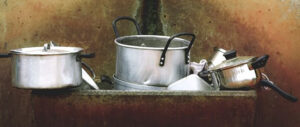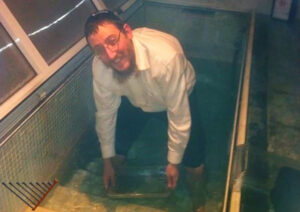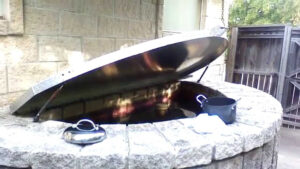|
Getting your Trinity Audio player ready...
|
By: Yehuda Shurpin
Did you just get new utensils? If so, you might have the opportunity to do a special mitzvah: tevilat keilim, the ritual immersion of these utensils in a mikvah.
In this article, you’ll learn which utensils need to be immersed, how the immersion is performed, and more.
The Source in the Torah

The source of the mitzvah is found in Numbers 31: Following a battle with the Midianites, the Jewish people returned with spoils of war, including utensils. They were instructed that in addition to purging the utensils from traces of unkosher food, they needed to immerse them in water.1
By delving into the language of this verse, the Talmudic sages derived many guidelines for this mitzvah, including which items must be immersed and the immersion method.2

Like many other mitzvahs, there is a special blessing to be said to thank G‑d for the opportunity to connect with Him and do this mitzvah. In some instances (which we’ll discuss later), the blessing is omitted because there is ambiguity as to whether the item truly needs to be immersed.
The Three Criteria for Immersion:
Made of specific materials, such as metal or glass
Intended for food
Previously owned by a non-Jew
Made of specific materials, such as metal or glass
Metal and glass: All metal (including gold, silver, stainless steel, copper, etc.) and glass utensils need to be immersed with a blessing.3
Glazed china or ceramics: These should be immersed without a blessing.4
Plastic, nylon and silicone: While most don’t immerse them, some immerse these items without a blessing.5
Wood, plain earthenware, stoneware, bone and horn: These items are exempt from the immersion requirement.
What about utensils made of a mix of materials, such as wood and metal?
These require immersion. If the components made from a material requiring immersion are (1) essential to the function of the utensil and (2) come in contact with the food (e.g., the metal blade of a blender), then a blessing should be said. If not, the blessing is omitted.6
Do disposable utensils require immersion?
Disposables generally do not require immersion. If you plan on reusing non-durable utensils, there are different opinions on whether immersion is required.7
Which Materials Require Immersion:
MATERIAL REQUIRES IMMERSION BLESSING RECITED
Aluminum pan – Disposable No No
Aluminum pan
Disposable intended for reuse Many are lenient No
Aluminum pan – Non-disposable Yes Yes
Bone No No
Disposable See aluminum pan
Earthenware No No
Earthenware coated
with glass or metal Yes No
Enamel Yes No
Glass (including crystal, Pyrex,
Duralex, and Corelle ) Yes Yes
Jars bought with food inside,
which one wishes to reuse
after emptying Yes No
Metal – all (including aluminum, copper,
gold, silver iron, lead, stainless steel and tin) Yes Yes
Metal with Teflon or Enamel coating Yes No
Mixture of materials requiring
and not requiring immersion Yes Depends (See article)
Nylon No (some are stringent) No
Paper No No
Plastic No (some are stringent) No
Porcelain Yes (as per custom) No
Rubber No (some are stringent) No
Silicon No (some are stringent) No
Stoneware No No
Stoneware coated
with metal or glass Yes No
Styrofoam No No
Wood No No
Wood coated
with metal or glass Yes No
Intended for food
What defines utensils “used for food”?
All utensils involved in food preparation, service and consumption require immersion. This includes tableware like cups, plates and bowls, as well as cutlery and serving platters. Cookware such as pots, pans and kettles (including their covers) need to be immersed if they come into contact with food or steam. Appliances that touch food directly during food preparation must also be immersed.
Do utensils that come into contact with inedible (raw) food require immersion?
If a utensil is used exclusively for inedible (raw) food, and additional preparation (such as cooking) is necessary to make the food edible, the utensil should be immersed without a blessing.8 For instance, while a regular peeler requires immersion with a blessing, a peeler used exclusively for raw potatoes (or a coffee grinder) should be immersed without one.
What about utensils that don’t come into direct contact with the food?
Utensils that don’t come into contact with food or beverages, like bottle and can openers, don’t require immersion. Containers used for wrapped food items, like individually wrapped tea bags, don’t need immersion (although some people choose to immerse them without a blessing).9
Storage containers such as jars, cans and bottles used for flour, sugar and similar commodities should be immersed without a blessing.10
According to most opinions, a nutcracker should be immersed without a blessing. (Some halachic authorities are of the opinion that if the nuts are usually shelled at the table, a blessing should be recited.)11
If a storage container is used to serve food at the table, it requires immersion with a blessing.12
Previously owned by a non-Jew
For a utensil to require immersion, it needs to have been previously owned by a non-Jew. So utensils sold by non-Jewish stores or manufactured by non-Jewish companies need to be immersed. If you’re unsure what to do, consult a qualified rabbi.
Do electric appliances need to be immersed?
According to most opinions, this mitzvah applies to electrical appliances (see below regarding what to do if you fear they’ll be damaged by water).
If an item won’t get damaged by the immersion, you only need to immerse the part that comes into contact with food or liquids, excluding the electrical cord. However, the section of cord near the appliance should be immersed together with the appliance. For safety reasons, it’s recommended to wait at least 48 hours for the appliance to fully dry before use.
If an item may be damaged by immersion, there are two ways to exempt it from immersion: (1) have the appliance disassembled to the point that it is not usable, and then reassembled by a Jewish technician (simply removing a few components or screws and putting them back in doesn’t suffice); or (2) give the utensil as a gift to a non-Jew and then “borrow” it back.
(There are some who are lenient regarding appliances that will definitely get ruined and are only used when plugged into an outlet, which is considered “connected to the ground.” Consult your rabbi if the above options aren’t viable.)
What if the item is too big to fit in a mikvah?
Follow the alternative options in the previous question about electrical appliances.
Which Items Require Immersion:
TYPE OF UTENSIL REQUIRES IMMERSION BLESSING RECITED
BBQ Grill Yes (just grill) Yes
Bottle or can opener
(including corkscrews, etc.) No No
Cookware and bakeware
(pots, pans, covers, bakepans, etc.) Yes Yes
Food processor Yes Yes
Grater Yes Yes
Grinder Yes Yes
Tableware
(bowls, cups, cutlery, plates, etc.) Yes Yes
Used for (edible) food preparation Yes Yes
Used for partial (but still unedible)
food preparations
(flour sieve, raw meat grinder, etc.) Yes No
Scissors Yes If only for raw poultry – no. If for cooked food as well – yes.
Serving dishes Yes Yes
Microwave glass turntable Yes No
Measuring spoon Yes No
Nutcracker Yes No
Peelers Yes Yes
Storage containers
(food directly inside) Yes No
Storage for wrapped food
(i.e., no direct contact with food) No (some are stringent) No
Stove grate No No
Tableware
(bowls, cups plates, forks,
knives spoons, etc.) Yes Yes
When can I perform tevilat keilim?
Immersion can be done any time during the week (day and night), but not during Shabbat or biblical holidays.13
Where do I need to immerse the utensils?

Utensils should be immersed in a kosher mikvah. Many communities have special mikvahs designated for this purpose. If you don’t have a mikvah in your area, talk to a competent rabbi. You might be able to use certain natural bodies of water (such as lakes). But don’t use man-made bodies of water, like swimming pools.
Who may do the immersion?
Any man or woman over bar or bat mitzvah can immerse the utensils. Since you don’t need to have any special intention in mind during the immersion, a Jewish child can do the dipping, as long as a Jew over bar or bat mitzvah is supervising.14
If you’re dipping a lot of items, you can make the blessing, immerse at least one item, and allow a non-Jew to immerse the rest, as long as a Jewish adult supervises to make sure the immersion was done properly.15
How do you immerse the utensils in the mikvah?
Before immersion, make sure your utensils are ready. During immersion, the water of the mikvah needs to touch the entire vessel, inside and out, so you need to remove any substance that would prevent the water of the mikvah from making contact with the surface of the utensil. This includes dirt, rust, stickers, label glue and price markings. Steel wool or acetone (nail polish remover) can be used to remove all traces of surface markings.
What is the blessing said before immersion?
If a blessing needs to be recited before the immersion (see above), say:16
Bah-rookh ah-tah Ah-doh-noy Eh-loh-hay-noo meh-lekh hah-oh-lahm ah-shehr keed-shah-ׁnoo bi-meetz-voh-tav vi-tzee-vah-noo ahl ti-vee-laht (when immersing one item say:) keh-lee / (when immersing many, say:) kay-leem.
Blessed are You, L-rd our G‑d, King of the Universe, Who has sanctified us with His commandments, and commanded us concerning the immersion of (a) vessel(s).
בָּרוּךְ אַתָּה ה’ אֱלֹהֵינוּ מֶלֶךְ הָעוֹלָם אֲשֶׁר קִדְּשָׁנוּ בְּמִצְוֹתָיו וְצִוָּנוּ עַל טְבִילַת כֶּלִי (כֵּלִים)
How do I hold the utensils during immersion?
When immersing a utensil, hold it loosely so the water can come in contact with all parts of the vessel. Or you can move your hands on the utensil while it’s submerged, ensuring that each part comes into contact with the water, even if only for a moment. Another option is to place one hand in the water, then lower the hand holding the utensil onto the submerged hand, allowing the utensil to rest on the first hand while both are underwater.17
Utensils should be completely immersed in the mikvah, including their handles.18 While the item is submerged, move it around to ensure the water reaches all surfaces.
Multiple utensils can be immersed together in a tray, crate, or mesh bag that allows the water to flow in and make contact with all sides of the utensils.
Each item needs to be immersed only once.
Can I use the utensil once without immersion?
This is a common misconception. The answer is no.19 (Disposable vessels don’t need to be immersed, but that’s because they lack the status of a proper vessel, not because of the number of times they’ll be used.)
What happens if I used a utensil that wasn’t immersed?
Even though you’re not supposed to use an un-immersed utensil, the food stays kosher and can be eaten20 (unlike with an unkosher utensil, which can cause the food to become non-kosher). Still, as soon as you realize the utensil wasn’t immersed, transfer the food to another utensil.
What should I do if I don’t have a mikvah available?
You might be able to use a natural body of water, such as a lake or stream. Talk to a qualified rabbi to find out which are accep
 table.
table.
If you don’t have any natural bodies of water around, see the discussion above regarding large or sensitive appliances that can’t be immersed.
What if the utensil also needs to be kashered – what should be done first?
If the utensil was used for non-kosher food and requires kashering in addition to immersion, kasher the utensil first and then immerse it in the mikvah. If you immersed the utensil before kashering, consult a rabbi.21
FOOTNOTES
- Numbers 31:21-23.
- See Talmud, Avodah Zarah 75b.
- See Shulchan Aruch, Yoreh De’ah 120:1.
- See commentaries to Shulchan Aruch, Yoreh De’ah 120:1.
- See Tevilat Keilim 11:147 and fn. 115.
- See Shulchan Aruch, Yoreh De’ah 120:7 and commentaries ad loc.
- See Tevilat Keilim 1:7.
- See Rama, Shulchan Aruch, Yoreh De’ah 120:5 and commentaries ad loc.; Tevilat Keilim 1:3.
- See Shulchan Aruch, Yoreh De’ah 120:4; Tevilat Keilim 1:4 and fn. 7.
- See Tevilat Keilim 11:191 and fn. 145.
- See Shulchan Aruch, Yoreh De’ah 120:4; Tevilat Keilim 1:4 and 11:124.
- See Tevilat Keilim 11:191
- Shulchan Aruch HaRav, Orach Chaim 323:8.
- See Shulchan Aruch, Yoreh De’ah 120:14 and commentaries ad loc.
- See Shulchan Aruch, Yoreh De’ah 120:15 and commentaries ad loc.
- Shulchan Aruch, Yoreh De’ah 120:3
- See Shulchan Aruch, Yoreh De’ah 120:2 and commentaries ad loc.
- Shulchan Aruch, Yoreh De’ah 120:12.
- Rama, Shulchan Aruch, Yoreh De’ah 120:8.
- Rama, Shulchan Aruch, Yoreh De’ah 120:16.
21 Shulchan Aruch, Yoreh De’ah 121:2.



